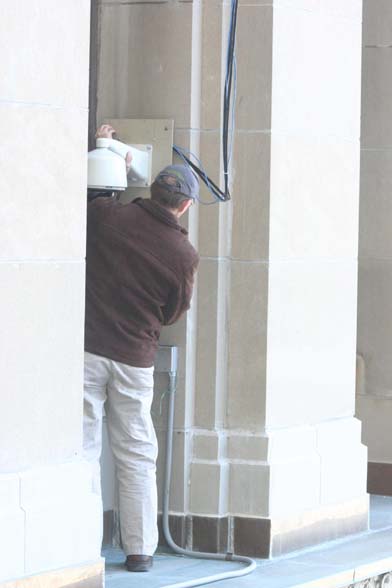Click here to read what happened earlier
FALCON FLASH
Dateline: Cleveland, Ohio
March 27,2012
Incubating, egg-turning, patience………….
Guarding the nest…..
and hunting for food……
SW and Boomer are doing a very good job during incubation.
As we wait for the eggs to hatch at our study nestsite, it is interesting to think about how human behavior has affected falcon behavior. As you know, cliff dwelling peregrine falcons have moved onto human built skyscrapers in recent history, and humans have helped them to nest successfully by building nestboxes so the eggs won’t roll off the skyscraper ledges. This is SW on the nestbox ledge.
Mr. Harvey Webster, Director of Wildlife Resources at the Cleveland Museum of Natural History, built SW and Boomer’s nestbox in 1991, and it has been used successfully by peregrine falcon couples ever since. According to the Canadian Peregrine Foundation: "… Peregrines were renowned for having remarkably stable populations [until the use of DDT caused numbers to decline]. Records are best documented for Great Britain, where the breeding population remained steady around 800 pairs from the time of Queen Elizabeth I to the Second World War nearly 400 years later. Even more amazingly, some particular nest sites were almost continuously occupied throughout this period." Visit http://www.peregrine-foundation.ca/
for a lot more interesting information.
In the last 100 years in North America, peregrine populations have been drastically affected by human behavior. In the late 1800s, a popular hobby was collecting eggs from wild nests, and hundreds of falcon chicks did not hatch as a result. As the number of falcons in the U.S. began to decline, The Migratory Bird Treaty Act of 1918 was passed to help protect the birds from these human activities. A more serious threat from humans occurred after 1950 when peregrine falcon populations began to decline rapidly due to the effects of the pesticide DDT. By the 1970s the species peregrine falcon (along with other bird species) was near extinction. Use of DDT was banned in the United States in 1972 which paved the way for recovery.]
Here is Mr. Webster on SW and Boomer’s skyscraper fixing the FalconCam that is sponsored by the Cleveland Museum of Natural History.
Don’t look down, Mr. Webster!
Volunteers across the country have also helped the species peregrine falcon in its recovery from near extinction. Volunteer nest monitor Mr. Scott Wright has been watching over the peregrines at this nestsite for over 20 years. Here he is rescuing a fledgling in a failed flying attempt that landed the young falcon in danger on a busy street. Mr. Wright rescued the youngster, gave him an elevator ride back up to the 12th floor, and put him outside the window into his skyscraper nest.
Mr. Wright visited the nest recently and caught the following pictures as he watched a “shift change”. Here is Boomer on the nest.
Then the shift change…….
Then SW was back on the eggs. What do you think she has in her beak?
To watch the falcons live go to: http://www.falconcam-cmnh.org/news.php Our thanks to the Cleveland Museum of Natural History for sponsoring the FalconCams and for the still of the scary view from the nest.
For more about falcons, go to: http://raptorsinthecity.org/
Photos are courtesy of Scott Wright, volunteer peregrine nest monitor. They may be used in any non-commercial publication, electronic or print, but please give photo credit.
Click here to read what happened next










